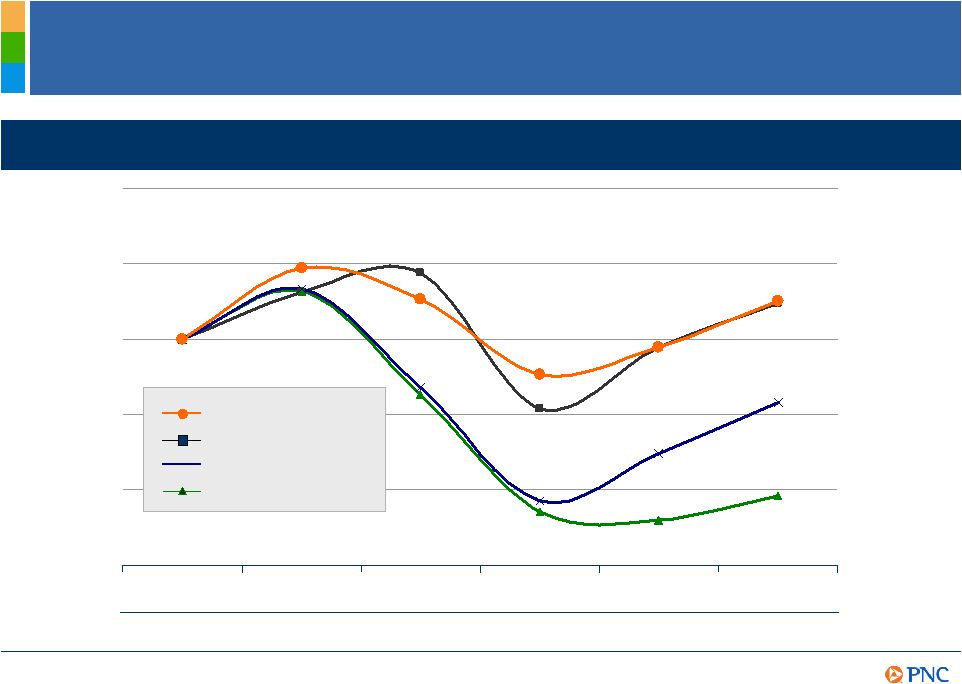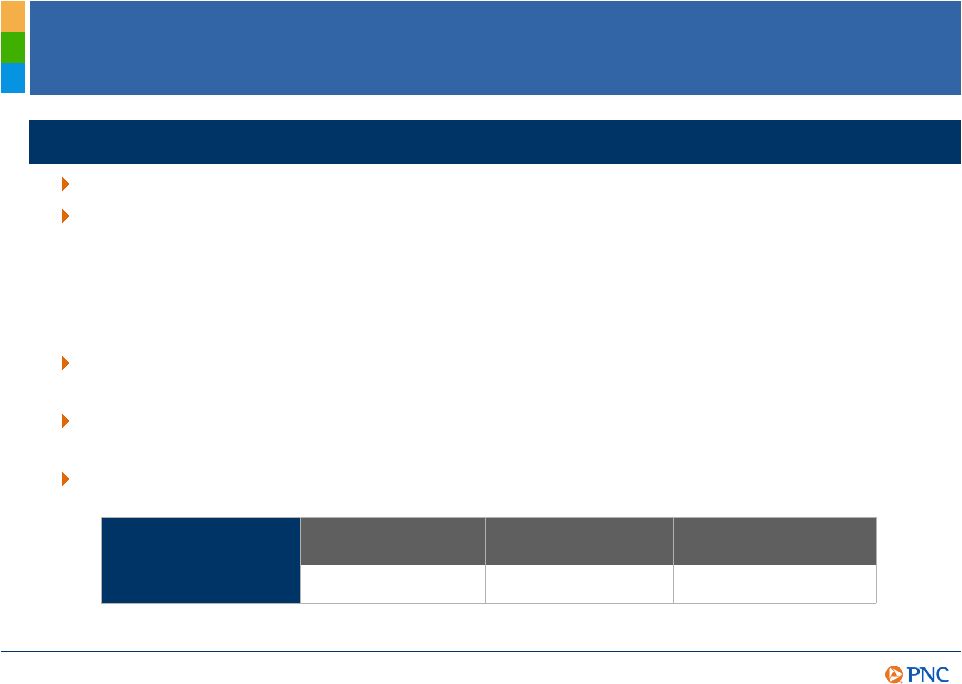Attached files
| file | filename |
|---|---|
| 8-K - FORM 8-K - PNC FINANCIAL SERVICES GROUP, INC. | d8k.htm |
  The PNC Financial
Services Group, Inc. Annual Meeting of Shareholders
April 26, 2011
Exhibit 99.1 |
 James E.
Rohr Chairman and Chief Executive Officer |
 3
Cautionary Statement Regarding Forward-Looking
Information and Adjusted Information
This presentation includes “snapshot” information about PNC used by way of
illustration. It is not intended as a full business or financial review and should be
viewed in the context of all of the information made available by PNC in its SEC
filings. The presentation also contains forward-looking statements regarding
our outlook or expectations for earnings, revenues, expenses, capital levels, liquidity
levels, asset quality and/or other matters regarding or affecting PNC and its future
business and operations. Forward-looking statements are necessarily subject to numerous assumptions, risks and uncertainties, which change over
time.
The forward-looking statements in this presentation are qualified by the
factors affecting forward-looking statements identified in the more detailed
Cautionary Statement included in the Appendix, which is included in the version of the
presentation materials posted on our corporate website at
www.pnc.com/investorevents. We provide greater detail regarding some of these factors in
our 2010 Form 10-K, including in the Risk Factors and Risk Management sections of
that report, and in our subsequent SEC filings (accessible on the SEC’s website at www.sec.gov and on or through our corporate
website at www.pnc.com/secfilings). We have included web addresses here and elsewhere in
this presentation as inactive textual references only. Information on these
websites is not part of this presentation.
Future events or circumstances may change our outlook or expectations and may also affect the
nature of the assumptions, risks and uncertainties to which our forward-looking
statements are subject. The forward-looking statements in this presentation speak only as of the date of this presentation. We do not
assume any duty and do not undertake to update those statements. In our
presentations, we sometimes refer to adjusted results to help illustrate the impact of certain types of items, such as our third quarter 2010 gain
related to the sale of PNC Global Investment Servicing Inc. (“GIS”), the
acceleration of accretion of the remaining issuance discount on our TARP preferred
stock in connection with the first quarter 2010 redemption of such stock, our fourth quarter
2009 gain related to BlackRock’s acquisition of Barclays Global Investors (the
“BLK/BGI gain”), our fourth quarter 2008 conforming provision for credit losses for National City, and integration costs in the 2010 and 2009
periods. This information supplements our results as reported in accordance with GAAP
and should not be viewed in isolation from, or a substitute for, our GAAP
results. We believe that this additional information and the reconciliations we provide may be useful to investors, analysts, regulators and others as
they evaluate the impact of these respective items on our results for the periods presented
due to the extent to which the items are not indicative of our ongoing operations. We
may also provide information on pretax pre-provision earnings (total revenue less noninterest expense), as we believe that pretax
pre-provision earnings, a non-GAAP measure, is useful as a tool to help evaluate the
ability to provide for credit costs through operations. Where applicable, we
provide GAAP reconciliations for such additional information.
In certain discussions, we may also provide information on yields and margins for all
interest-earning assets calculated using net interest income on a
taxable-equivalent basis by increasing the interest income earned on tax-exempt assets
to make it fully equivalent to interest income earned on taxable investments. We
believe this adjustment may be useful when comparing yields and margins for all earning assets. We may also use annualized, proforma,
estimated or third party numbers for illustrative or comparative purposes only. These
may not reflect actual results.
This presentation may also include discussion of other non-GAAP financial measures, which,
to the extent not so qualified therein or in the Appendix, is qualified by GAAP
reconciliation information available on our corporate website at www.pnc.com under “About PNC–Investor Relations.” |
 4
Overview
PNC delivered an exceptional year in a challenging
environment
PNC’s business model is designed to deliver
strong results and long-term value for our
constituencies
PNC’s first quarter results highlight our
momentum
PNC is well positioned to capture future growth
PNC Continues to Build a Great Company.
PNC Continues to Build a Great Company. |
 5
Delivered Exceptional 2010 Performance
Grew our businesses and delivered record net income of
$3.4 billion in 2010
Transitioned to a higher quality balance sheet
Improved our capital ratios to record levels
Implemented the PNC sales and service model and
successfully grew clients across our businesses
Exceeded our original acquisition-related cost savings target
Actively managed our risk positions toward a moderate
profile
PNC Is Positioned to Deliver Even Greater Shareholder Value.
PNC Is Positioned to Deliver Even Greater Shareholder Value. |
 6
0
25
50
75
100
2003
2004
2005
2006
2007
2008
2009
2010
2011
2012
2013
Recognizing Changing Customer Preferences
Customers have more choices and want more control
US banking transactions by channel (billions)
Mobile
Online
ATM
Call center
Branch
Source: Tower Group, McKinsey & Co.
Growth in electronic
channels continues to
reduce consumer
check payments
In 2002, checks
accounted for 48% of
non-cash transactions
By 2012, checks are
expected to account
for only 17% of
non-cash transactions
Forecast
Actual |
 7
Footprint covering nearly 1/3 of the U.S.
population
Retail
Corporate & Institutional
A leader in serving middle-market
customers and government entities
One of the largest bank-held asset
managers in the U.S.
Asset Management
Residential Mortgage
National distribution capabilities
PNC’s Powerful Franchise
Dec. 31, 2010
U.S. Rank
Deposits
$183B
6
Assets
$264B
6
Branches
2,470
5
ATMs
6,673
5
Record 2010 net income of $3.4B
(1)
Rankings
source:
SNL
DataSource;
Banks
headquartered
in
U.S.
Assets
rank
excludes
Morgan
Stanley
and
Goldman
Sachs.
CO
TX
KS
OK
BlackRock
A leader in investment management, risk
management and advisory services worldwide
th
th
th
th
1 |
 8
Our Business Model is Delivering Strong Results and
Long-Term Value
A successful business model
Delivering value for our stakeholders
Core funded, disciplined deposit
pricing
Returning to a moderate risk profile
Leveraging customer relationships,
strong brand to grow high quality,
diverse revenue streams
Focus on creating positive operating
leverage, invest in innovation
Remaining disciplined with capital
Execute
SHAREHOLDERS
Return
Operating
leverage
Capital utilization
CUSTOMERS
Engagement
Brand equity
Customer growth
Market share
EMPLOYEES
Engagement
Talent
management
Diversity
COMMUNITIES
Community-based
spending
Grow Up Great
Green initiatives |
 9
Delivering Long–Term Value for Our Shareholders
$25
$50
$75
$100
$125
$150
2005
2006
2007
2008
2009
2010
December 31
PNC
S&P 500 Index
Peer
Group
¹
S&P 500 Banks
X
Comparison of cumulative 5-year total return
(1) Peer group represents BBT, BAC, COF, CMA, FITB, JPM, KEY, MTB, PNC, RF, STI, USB and
WFC. |
 10
Significant 1Q11 Achievements
1Q11 financial
summary
Net income
Diluted EPS from
net income
Return on
average assets
$832 million
$1.57
1.29%
Delivered strong financial results through the execution of our business model
Record capital levels
-
Increased quarterly common stock dividend 250% to $0.35 per share for
2Q11
-
Confirmed 25 million share repurchase program; plan to repurchase up to
$500 million
in
2011
¹
Businesses continued to grow clients, deepen relationships and launch new
products
Continued to maintain a high quality balance sheet, poised to support client
growth
Actively managed our risk positions toward a moderate profile
1Q11 highlights
(1) Subject to market and general economic conditions, economic and regulatory capital
conditions, alternative uses of capital, regulatory and contractual limitations, and
potential impact on credit ratings. |
 11
PNC’s Growth Opportunities
Time
Disciplined
expense
management
Growth
through
execution
Growth
through
lending
Growth
through
innovation
Growth
through
market share
Credit quality
improvement
Capital
management
Higher
interest rates |
 12
Cautionary Statement Regarding Forward-Looking
Information
Appendix
This presentation includes “snapshot” information about PNC used by way of
illustration and is not intended as a full business or financial review. It should
not be viewed in isolation but rather in the context of all of the information made available by PNC in its SEC filings.
We also make statements in this presentation, and we may from time to time make other
statements, regarding our outlook or expectations for earnings, revenues, expenses,
capital levels, liquidity levels, asset quality and/or other matters regarding or affecting PNC and its future
business and operations that are forward-looking statements within the meaning of the
Private Securities Litigation Reform Act. Forward- looking statements are
typically identified by words such as “believe,” “plan,” “expect,” “anticipate,” “intend,” “outlook,” “estimate,” “forecast,
“will,” “should,” “project,” “goal” and other similar
words and expressions. Forward-looking statements are subject to numerous assumptions,
risks and uncertainties, which change over time.
Forward-looking statements speak only as of the date they are made. We do not assume any
duty and do not undertake to update our forward-looking statements. Actual
results or future events could differ, possibly materially, from those that we anticipated in our forward-
looking statements, and future results could differ materially from our historical
performance. Our forward-looking statements are subject to the following principal risks and
uncertainties. We provide greater detail regarding some of these factors in our
2010 Form 10-K, including in the Risk Factors and Risk Management sections of that report, and in our subsequent SEC
filings. Our forward-looking statements may also be subject to other risks and
uncertainties, including those that we may discuss elsewhere in this presentation or in
our filings with the SEC, accessible on the SEC’s website at www.sec.gov and on or through our corporate website at
www.pnc.com/secfilings. We have included these web addresses as inactive textual
references only. Information on these websites is not part of this document.
•Our businesses and financial results are affected by business and economic conditions,
both generally and specifically in the principal markets in which we operate. In
particular, our businesses and financial results may be impacted by:
o
Changes in interest rates and valuations in the debt, equity and other financial markets.
o
Disruptions in the liquidity and other functioning of financial markets, including such
disruptions in the markets for real estate and other assets commonly securing financial
products. o
Actions by the Federal Reserve and other government agencies, including those that impact
money supply and market interest rates. o
Changes in our customers’, suppliers’ and other counterparties’ performance in
general and their creditworthiness in particular. o
A slowing or failure of the moderate economic recovery that began in mid-2009 and
continued throughout 2010 and into 2011. o
Continued effects of the aftermath of recessionary conditions and the uneven spread of the
positive impacts of the recovery on the economy in general and our customers in
particular, including adverse impact on loan utilization rates as well as delinquencies, defaults
and customer ability to meet credit obligations.
o
Changes in levels of unemployment.
o
Changes in customer preferences and behavior, whether as a result of changing business and
economic conditions, climate-related physical changes or legislative and regulatory
initiatives, or other factors. •Turbulence in significant portions of the US and
global financial markets could impact our performance, both directly by affecting our
revenues and the value of our assets and liabilities and indirectly by affecting our
counterparties and the economy generally. |
 13
Cautionary Statement Regarding Forward-Looking
Information (continued)
•We will be impacted by the
extensive
reforms
provided
for
in
the
Dodd-Frank
Wall
Street
Reform
and
Consumer
Protection
Act
(“Dodd-Frank
Act”)
and ongoing reforms impacting the financial institutions industry generally. Further, as
much of the Dodd-Frank Act will require the adoption of implementing regulations by
a number of different regulatory bodies, the precise nature, extent and timing of many of these reforms and the impact
on us is still uncertain.
•Financial
industry
restructuring
in
the
current
environment
could
also
impact
our
business
and
financial
performance
as
a
result
of
changes
in
the
creditworthiness and performance of our counterparties and by changes in the competitive and
regulatory landscape. •Our results depend on our ability to manage current elevated
levels of impaired assets. •Given current economic and financial market conditions,
our forward-looking financial statements are subject to the risk that these conditions will be
substantially different than we are currently expecting. These statements are based on our
current view that the moderate economic recovery that began in mid-2009 and
continued throughout 2010 will transition into a self-sustaining economic expansion in 2011 pushing the unemployment rate
lower amidst continued low interest rates.
•Legal and regulatory developments could have an impact on our ability to operate our
businesses or our financial condition or results of operations or our competitive
position or reputation. Reputational impacts, in turn, could affect matters such as business generation and retention, our ability to
attract and retain management, liquidity, and funding. These legal and regulatory
developments could include: o
Changes resulting from legislative and regulatory responses to the current economic and
financial industry environment. o
Other legislative and regulatory reforms, including broad-based restructuring of financial
industry regulation (such as that under the Dodd-Frank Act) as well as changes to
laws and regulations involving tax, pension, bankruptcy, consumer protection, and other aspects of the financial
institution industry.
o
Unfavorable resolution of legal proceedings or other claims and regulatory and other
governmental investigations or other inquiries. In addition to matters relating
to PNC’s business and activities, such matters may also include proceedings, claims, investigations, or inquiries relating to
pre-acquisition
business
and
activities
of
acquired
companies,
such
as
National
City.
These
matters
may
result
in
monetary
judgments or
settlements or other remedies, including fines, penalties, restitution or alterations in our
business practices and in additional expenses and collateral costs.
o
The results of the regulatory examination and supervision process, including our failure to
satisfy the requirements of agreements with governmental agencies.
o
Changes in accounting policies and principles.
o
Changes
resulting
from
legislative
and
regulatory
initiatives
relating
to
climate
change
that
have
or
may
have
a
negative
impact
on
our
customers’
demand for or use of our products and services in general and their creditworthiness in
particular. o
Changes to regulations governing bank capital, including as a result of the Dodd-Frank Act
and of the Basel III initiatives. •Our business and operating results are affected
by our ability to identify and effectively manage risks inherent in our businesses, including, where
appropriate,
through
the
effective
use
of
third-party
insurance,
derivatives,
and
capital
management
techniques,
and
by
our
ability
to
meet
evolving
regulatory capital standards.
•The adequacy of our intellectual property protection, and the extent of any costs
associated with obtaining rights in intellectual property claimed by others, can impact
our business and operating results. •Our ability to anticipate and respond to
technological changes can have an impact on our ability to respond to customer needs and to meet
competitive demands.
•Our ability to implement
our
business
initiatives
and
strategies
could
affect
our
financial
performance
over
the
next
several
years.
•Competition can have an impact on customer acquisition, growth and retention, as well as
on our credit spreads and product pricing, which can affect market share, deposits and
revenues. Appendix |
 14
Cautionary Statement Regarding Forward-Looking
Information (continued)
•Our business and operating results can also be affected by widespread disasters,
terrorist activities or international hostilities, either as a result of the impact on
the economy and capital and other financial markets generally or on us or on our customers, suppliers or other counterparties
specifically.
•Also, risks and uncertainties that could affect the results anticipated in
forward-looking statements or from historical performance relating to our equity
interest in BlackRock, Inc. are discussed in more detail in BlackRock’s filings with the SEC, including in the Risk Factors sections of
BlackRock’s reports. BlackRock’s SEC filings are accessible on the SEC’s
website and on or through BlackRock’s website at www.blackrock.com. This material
is referenced for informational purposes only and should not be deemed to constitute a part of this document.
We grow our business in part by acquiring from time to time other financial services
companies, financial services assets and related deposits. Acquisitions present
us with risks in addition to those presented by the nature of the business acquired. These include risks and uncertainties
related both to the acquisition transactions themselves and to the integration of the acquired
businesses into PNC after closing. Acquisitions may be substantially more expensive to
complete (including unanticipated costs incurred in connection with the integration of the
acquired company) and the anticipated benefits (including anticipated cost savings and
strategic gains) may be significantly harder or take longer to achieve than
expected. Acquisitions may involve our entry into new businesses or new geographic or other markets, and these situations also
present risks resulting from our inexperience in those new areas.
As a regulated financial institution, our pursuit of attractive acquisition opportunities
could be negatively impacted due to regulatory delays or other regulatory issues.
In addition, regulatory and/or legal issues relating to the pre-acquisition operations of an acquired business may cause
reputational harm to PNC following the acquisition and integration of the acquired business
into ours and may result in additional future costs or regulatory limitations arising
as a result of those issues. Any annualized, proforma, estimated, third party or
consensus numbers in this presentation are used for illustrative or comparative purposes only
and may not reflect actual results. Any consensus earnings estimates are calculated
based on the earnings projections made by analysts who cover that company. The
analysts’ opinions, estimates or forecasts (and therefore the consensus earnings
estimates) are theirs alone, are not those of PNC or its management, and may not
reflect PNC’s or other company’s actual or anticipated results. Appendix
|
